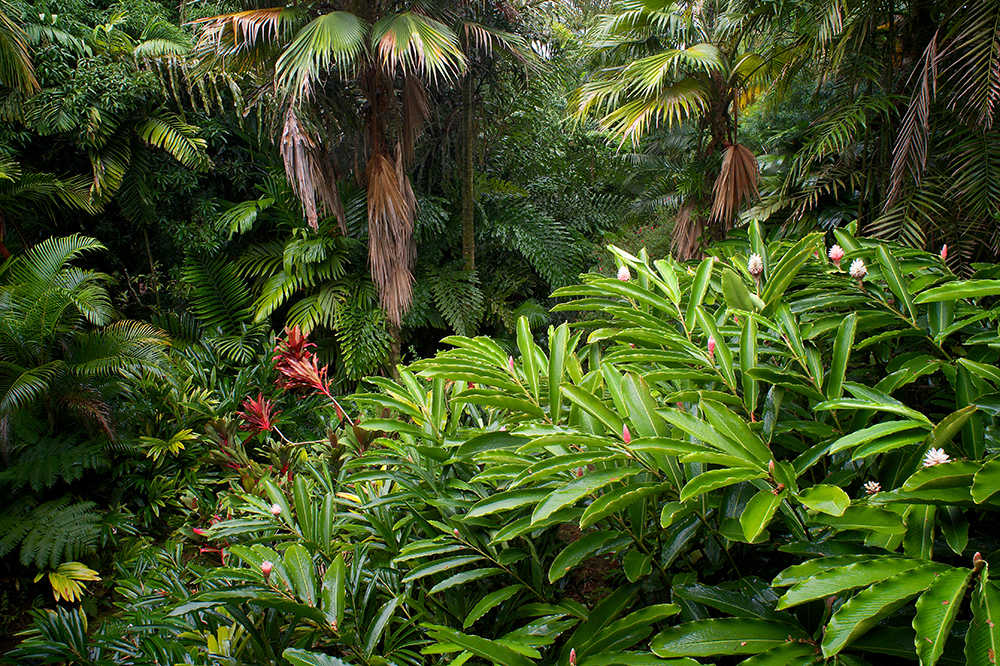
This Unfolding Story
“Director’s Notes” are excerpts from our monthly email newsletter, “Stories from the Garden.” Subscribe and see past issues here.
Dear Friends,
Lately my nights have holes in them. Well before dawn I wake for a spell, and it’s not at all unpleasant. I relish silence, stillness.
My mid-night mind meanders to the valley floor, one of the most peaceful places I know. Peaceful, but not often silent: swell of the trade winds, song of the thrush (and call of the rooster, who himself is out of sync with the hour). And sometimes, sounds of rain. Few drops make their way to the ground, but on their descent through the layered canopy, they give sound to texture. Raindrops swish through the Caryota gigas, the huge fishtail palms at the top. Then they slide along the creases of the loulu (Pritchardia), and farther down form a rhythm section on the pleated paddles of the Johannesteiljsmannia altifrons.
Late thoughts turn from the lush valley floor to the sloped stretch of garden now open to the sky. Here, the Kona winds of February took down a tumble of trees, including one of the first Ironwoods that W.S. Merwin planted, and several palms. Last week, our board members stood in this spot together and looked up at a wide swath of blue sky—a rare sight in this dense garden. Those Kona winds had invited us into a moment much like the one when William first looked across a whole open valley, its soil scorched and depleted. In that moment, William decided to participate in the well-being of this place by making a home here, and over time, a garden much like a forest. Forty-five years later, the sun’s rays reach soil restored by curiosity and commitment, and we, the new gardeners, consider our own participation.
In daylight I continue to ponder our role—as a board and staff and as a collective—in caring for this garden and the whole earth. And as often happens, I come upon a text of William’s that speaks to this particular moment. Once again, it’s an essay I’ve read before, but now take in anew. William published Coming to Palms in 2016, in the gorgeous book “What is a Garden?” I am astonished by its opening words:
Some time after midnight the wind drops and the silence wakes me.
Unlike my own nocturnal meanderings, William’s took him quite literally out to the garden, “to wander in the moonlight, looking at palms.” As he walks he reminisces about his early plantings of niu, coconut palms. He marvels at the towering “monkeypods that I planted as seedlings no taller than chives,” and at “the moonlight [that] reaches through to whiten night-blooming jasmine, plumerias, and understory palms.” He wonders about the gardener’s role:
There have been countless notions of what a garden is since the beginning…The variations have to do with what the age and its gardeners have thought of as the ideal relation with the wilderness, how they conceived of the role in it of their own artifice…My wish is for a garden that suggests on its own scale the forest, indeed the rain forest.
We gardeners gathered here have William’s words in mind: “only a forest knows how to make a forest.” And we wonder together how and where we will actively participate in regeneration through our choices of what to plant and where and how to plant it, and where we will step aside simply to marvel at the slow and resolute force of ecological succession. William offers:
The practice and art of gardening are remarkably pure forms of the element of paradox underlying all human art and language. A plant in a garden is at once the natural world itself and an object of human arrangement. In a garden we draw something of nonhuman life into our history. When we look at the wilderness we can see it as a place without time, something complete as it is. But looking at a garden, some of its recent evolution, the human intent behind it, is likely to be evident. A past that we recognize. A deliberated present.
Here we are in a deliberated and fleeting present, looking also to a future well beyond our own lifetimes. From Coming to Palms:
Of course a gardener is always seeing the garden as a future, something it is supposed to be turning into. Only occasionally can we see the garden itself as something complete, and a moment later we are likely to realize the evanescence of what we are seeing, the brevity of the cherished arrangement.
This unfolding story we’ve inherited and are now co-creating— along with and as part of nature itself—is one of change and evolution, past, present, and future. We keep this in mind as we move along:
A garden is made of hope, which contributes to its pleasure and its fragility. It cannot be proven, nor clutched, nor hurried. And the hope of a palm garden is to be a palm forest.
Wishing you a Happy Poetry Month, and a Happy Earth Day,
Sonnet